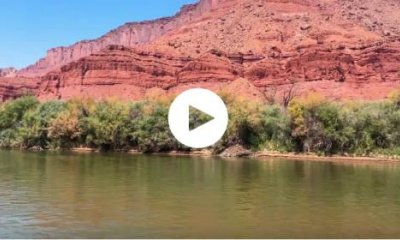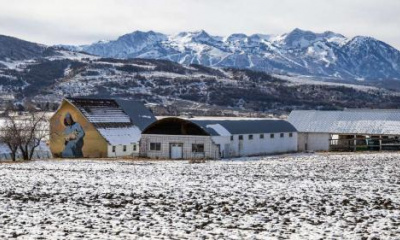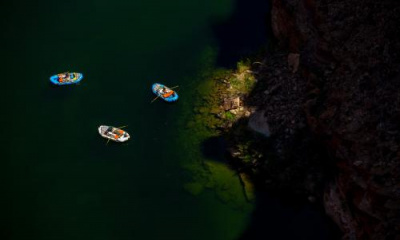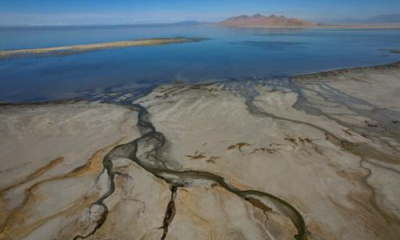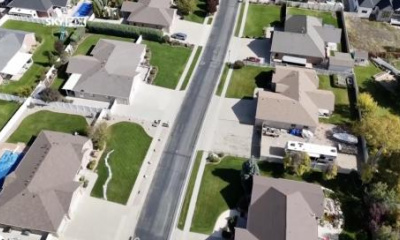BERYL, Utah — Craig Laub’s father started growing alfalfa hay here after he came home from the Army.
“He came home after World War II,” Laub said, “come out here and developed the farm from sagebrush.”
Now the Laub family grows 10,000 tons of alfalfa a year in the southwest Utah desert.
“Basically a matter of economics,” Laub explains. “We had to have a cash crop.”
Alfalfa farmers like Luab are trying to irrigate more efficiently, but Laub’s irrigation pivots are still drizzling 900 gallons a minute onto his alfalfa.
That means his field near Beryl is receiving as much water every 2-and-a-half hours as, according to U.S. Environmental Protection Agency estimates, the average family of four uses in a year.
About two-thirds of all water diverted in Utah goes to growing hay, said Gabriel Lozada, an associate professor of economics at the University of Utah. He recently wrote an analysis of hay and water in Utah.
If we were to stop growing hay today, how many more houses could we water in Utah? Lozada says residential water use could increase six times.
Yet hay farming in 2020 was less than 1% of Utah’s gross domestic product, Lozada found.
“And so the price system doesn't work for water in agriculture,” Lozada said.
That’s because farmers typically buy water rights when they purchase real estate. Unlike, say, many residential water bills, water rights holders don’t have to pay more based on consumption.
“And that generates huge inefficiencies,” Lozada said.
Mining is a much larger export for Utah. Coal and copper aren’t edible, and Lozada acknowledges: “Free market economics doesn't really take that into account.”
Hay became a cash crop in Western states because it’s durable. Alfalfa, for example, only needs to be replanted every five or six years, survives temperature extremes and doesn’t necessarily need any fertilizer or pesticides.
That doesn’t mean you just add water. Hay also requires a lot of labor and diesel fuel. Tractors and other farm implements cut it, rake it, chop it and spit it into trailers.
The Laub family hauls their chopped hay to a production facility near Beryl. The alfalfa is compressed into cubes – sort of like a hay bale the size of a saltshaker.
Some of their hay is sold to local ranchers. About a third of the Laubs’ cubes – and about a third of Utah hay overall – are sold overseas.
“We export to Japan and Taiwan, primarily,” Laub said.
Laub will brag about how efficient his farm is getting with water. At his field near Beryl, water used to shoot out of the top of his two-story tall irrigation pivots, some of the liquid evaporating before it hit the ground.
Now hoses with nozzles on their ends dangle from the pivot, drizzling water just inches from the ground. Money from the Utah Legislature has helped Laub and other farmers pay for the upgrades.
Utah Gov. Spencer Cox recently released a plan to help farmers conserve more water. It calls for more irrigation and technology upgrades. It does not discuss asking farmers to pay more or dissuading hay farming.
“We're close to three-acre feet now to raise the same crop that we raised four-acre feet earlier,” Laub said.
That doesn’t mean others can drink or bath in water that Laub conserves. Utah law requires water rights holders put the water to beneficial use or risk forfeiting their rights to it.
“It’s kind of a hot topic and Utah water law right now,” said Emily Lewis, who teaches water law at the University of Utah.
She said the state’s legal community is trying to find a framework where rights holders like Laub can easily sell excess water to other users.
“There are other states who have looked at this and adopted their laws to recognize a way to incentivize,” Lewis said.
Lewis says Utah water law is complicated, but has worked well. She pointed to the spot where she recently met the FOX 13 crew – City Creek Park in Salt Lake City.
“This was the place where Brigham Young’s exploratory party first dammed up City Creek Canyon,” she said.
“This really is Water Right No. 1 here in the state of Utah.”
Lozada agrees a water-trading system would benefit farmers and cities. It would also require infrastructure investments. Laub, for example, pumps his water out of the ground beneath his own fields. Anyone else wanting the water would have to transport it.
Meanwhile, Utah grew less than 2% of U.S hay in 2020. Lozada thinks a reduction in Utah hay would have little impact on food prices.
“It's not that farmers are doing anything bad,” Lozada said. “It's that the economic environment that we've put farmers in isn't appropriate for a climate that's getting more and more arid.”
“Unless somebody comes up with something better, it’s the cash crop,” Laub said. “It's the best crop for us to raise.
“You like to drink milk. You like beef. All these things that we raise. I mean, alfalfa directly is not any use to you, but it sure adds to your diet.”



